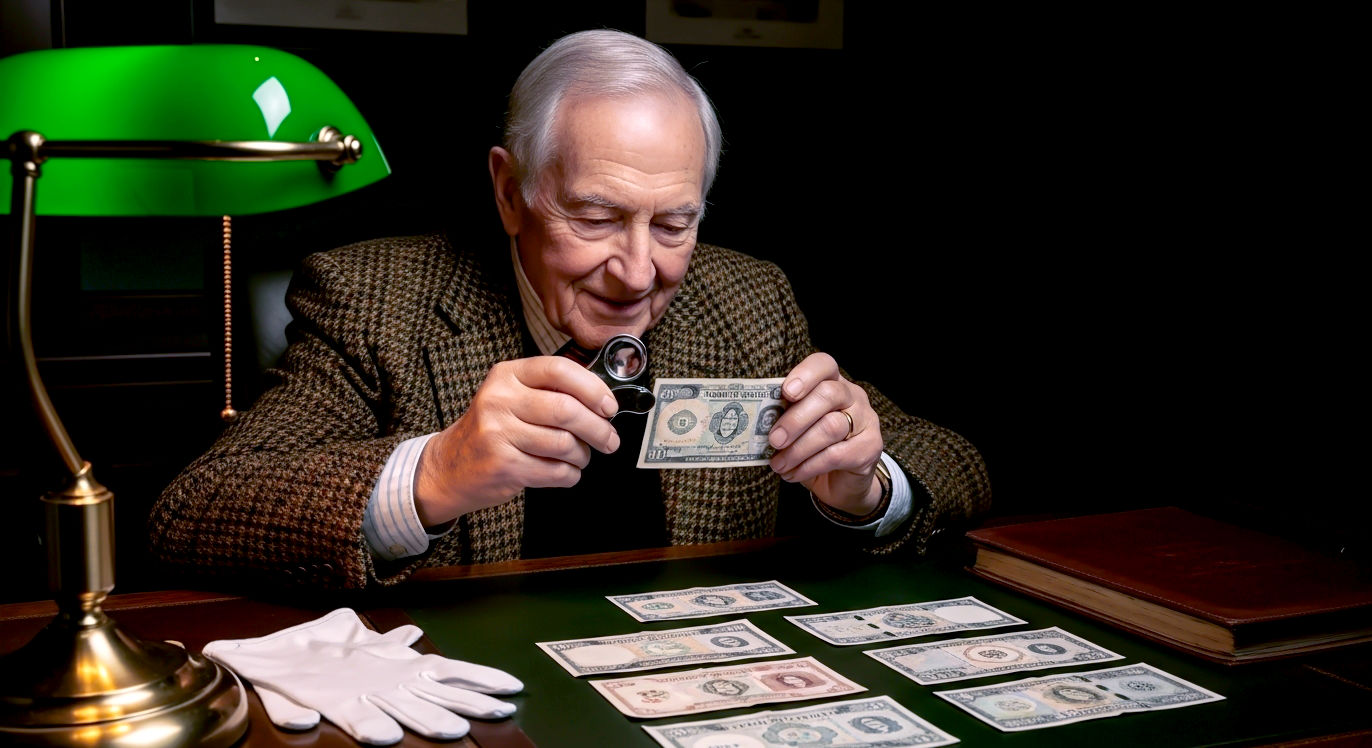The Great British Guide to Banknote Collecting: From White Fivers to Polymer Pounds
Unlock the secrets of notaphily with the UK’s most comprehensive guide to collecting banknotes. Learn to value, grade, and protect your paper and polymer treasures.

This post may contain affiliate links. If you make a purchase through these links, we may earn a commission at no additional cost to you.
Imagine this. You’re clearing out your nan’s attic on a drizzly Sunday afternoon. Tucked inside a dusty old copy of David Copperfield, a crisp white banknote flutters out. It feels different from the plastic-like notes in your pocket. It’s bigger, more ornate, and promises to pay the bearer the sum of five pounds. You’ve just stumbled into the fascinating world of notaphily—the hobby of banknote collecting.
It’s more than just hoarding old cash. It’s about holding a piece of history in your hands. Each note tells a story of its time: the art, the politics, the technology, and the people who shaped our nation. From the stark, simple notes issued when the Bank of England was just a start-up, to the high-tech polymer tenners featuring Jane Austen, British banknotes are miniature monuments to our national story.
Whether you’re wondering if that old note is worth a fortune or you’re looking for a new hobby that connects you to the past, you’ve come to the right place. This is your guide to becoming a banknote collector. We’ll look at what makes a note valuable, how to spot a treasure in your change, and how to look after your collection. So, grab a cuppa, and let’s unfold the secrets hiding in your wallet.
What is Notaphily? The ABCs of Banknote Collecting
Let’s start with the basics. Notaphily (pronounced no-ta-filly) is simply the study and collection of paper money or banknotes. It’s like stamp collecting, but for cash. People who do it are called notaphilists.
But why would anyone collect something that’s, well, just money?
- It’s a history lesson you can hold. A banknote is a snapshot of the era it was made in. The person on the note, the style of the design, and the security features all tell you something about the society that produced it. Collecting notes is like curating your own pocket-sized museum.
- They’re miniature works of art. Forget scribbling on a fiver; banknotes are incredibly detailed engravings. The artists who design them are masters of their craft, packing incredible detail into a tiny space. From the majestic Britannia to the intricate patterns on modern polymer, there’s a lot of beauty to appreciate.
- The thrill of the hunt. Like any collecting hobby, there’s a real buzz in finding that one rare note you’ve been looking for. It could be a note with a special serial number or a rare issue from a long-gone bank.
- It can be an investment. While you shouldn’t expect to get rich overnight, truly rare and high-quality banknotes can be worth a lot more than their face value. Some historic British notes have sold for tens of thousands of pounds at auction.
It’s important to know the difference between standard currency and a collectible note. The Alan Turing £50 note in your wallet is currency. But an Alan Turing £50 note with a very low serial number (like AI01 000007) is a collectible. The magic happens when factors like age, rarity, condition, and special features elevate a simple piece of money into a sought-after artefact.
A Pocket History of the British Banknote
To really understand collectible notes, you need to know where they came from. The story of the British banknote is a surprisingly dramatic one, filled with wars, forgeries, and incredible innovation.
The Early Days: Goldsmiths and I.O.Us
Before the Bank of England, there were the goldsmiths. Back in the 17th century, wealthy folk would leave their gold and silver with a trusted goldsmith for safekeeping. In return, they’d get a receipt, or a “note,” promising to pay them back their gold on demand.
People soon realised that trading these notes was much easier than lugging around heavy coins. These handwritten I.O.Us were the great-great-grandfathers of the banknotes we use today.
The Bank of England Steps In (1694)
In 1694, the Bank of England was set up to fund a war against France. To raise money, it started issuing its own official notes. These first notes were handwritten on bank paper, made out for specific amounts to specific people. They were more like a fancy cheque than the money we know now. The first fully printed notes didn’t appear until 1853.
The Era of the “White Fiver”
For nearly 200 years, the Bank of England’s most famous product was the “White Fiver.” Printed in black ink on white, one-sided paper, these notes were huge—about the size of a modern A5 piece of paper. They were the backbone of the British economy until 1956. Because £5 was a massive amount of money back then (months of wages for many), most ordinary people would never even see one. Finding a good-condition White Fiver today is a collector’s dream.
Bringing Colour to Our Cash: The Pictorial Series
Everything changed in the 20th century. After World War II, the Bank decided it was time to modernise.
- Series A (1928): The first 10-shilling and £1 notes were issued, featuring the iconic image of a seated Britannia. They were the first truly public notes, designed for everyday use.
- Series C “Portrait” (1960s): This was a huge step. For the first time, a monarch—Queen Elizabeth II—appeared on a Bank of England banknote. This series set the standard for modern British currency.
- Series D “Pictorial” (1970s-80s): This is the series many people remember fondly. It featured famous historical figures on the back for the first time: Sir Isaac Newton on the £1, the Duke of Wellington on the £5, Florence Nightingale on the £10, and William Shakespeare on the £20.
- Series E “Historical” (1990s): This series refined the design, with larger portraits and improved security features. It saw George Stephenson and his Rocket on the £5, and Michael Faraday, the father of electricity, on the £20.
- Series F & G (2000s-Present): The move to the “cleaner, safer, stronger” polymer. Starting with the Churchill £5 in 2016, these notes are packed with advanced security features and feature figures like Jane Austen, J.M.W. Turner, and Alan Turing. This transition made the last paper versions of each denomination (like the paper fiver with Elizabeth Fry) instantly collectible.
Don’t Forget the Scots and the Irish!
It’s not just the Bank of England that prints money. Banks in Scotland (Bank of Scotland, Clydesdale Bank, Royal Bank of Scotland) and Northern Ireland (Bank of Ireland, Danske Bank, Ulster Bank) also issue their own sterling notes. These are often more colourful and feature different historical figures and landmarks, making them a fascinating area to collect.
The Anatomy of a Banknote: What to Look For
To a casual observer, a banknote is just a banknote. To a collector, it’s a dense tapestry of clues. Knowing how to “read” a note is the key to understanding its story and its value. Let’s break one down.
The Serial Number: A Note’s Unique ID
This is often the most important feature for modern collectors. The serial number is like a car’s number plate; some are far more desirable than others.
- Prefix: The first two letters are the prefix. The very first prefix for a new note (like AA01 on the Churchill fiver) is the one everyone wants. The first notes printed are given to the Queen, Prince Philip, and the Prime Minister, but finding one with a low number from that first ‘AA’ run is a massive win.
- Low Numbers: The lower the six-digit number, the better. A number under 1,000 is considered very good. Anything under 100 is fantastic. The holy grail is a note like AA01 000007.
- “Fancy” Serial Numbers: Collectors love patterns. Keep an eye out for:
- Solid Numbers: All digits are the same (e.g., 888888).
- Ladder Numbers: The digits run in sequence, up or down (e.g., 123456 or 876543).
- Radar or Repeater Numbers: The number reads the same forwards and backwards (e.g., 123321) or repeats a pattern (e.g., 123123).
- Replacement Notes: When a sheet of notes is found to be faulty during printing, it’s destroyed and replaced with a special sheet. These replacement notes used to be marked with a special prefix (like ‘M’ or ‘LL’ in the past). These are much rarer than standard notes. With modern printing, they are less common, but historical examples are highly sought after.
The Signature: The John Hancock of the Bank
Every Bank of England note bears the signature of the Chief Cashier at the time it was printed. This is a crucial detail for dating older notes. When a new Chief Cashier takes over, their signature appears on the new notes. A collection can be built around getting one note from every single Chief Cashier. Some served for only a short time, making their notes rarer and more valuable.
The Date and Series
The date printed on the note tells you when that specific design was first introduced, not when the individual note was printed. The signature and serial number are better guides for pinpointing the exact era of a specific note.
Watermarks and Security Features
Security features are designed to stop forgers, but they also create interest for collectors.
- Watermarks: Hold an old note up to the light, and you’ll see a hidden portrait. This was one of the earliest security features.
- Metal Thread: The little silver strip running through the note. On early notes, it was a solid line. Later it became a “windowed” thread that weaves in and out of the paper.
- Holograms & Kinegrams: These are the shiny, complex patches on modern notes that change image as you tilt them.
- UV Features: Shine an ultraviolet (UV) light on a modern note, and you’ll see hidden numbers and patterns glow brightly.
The Printer
Most British notes were printed by the Bank of England’s own printing works or by famous private firms like De La Rue and Bradbury Wilkinson. Sometimes, the printer’s name is subtly included in the design, and collectors often specialise in notes from a specific printer.
The Golden Rules of Value: What Makes a Banknote Rare?
This is the big question: is my old tenner worth a tenner, or is it worth a thousand? The value of a collectible banknote is boiled down to three main things: Condition, Rarity, and Demand.
Condition is King: The Grading Scale
This is the most important factor of all. A common note in perfect condition will almost always be worth more than a super-rare note that’s been through the wash. Collectors are fussy, and they want the best they can get.
The condition of a banknote is described using a grading system. While there are very detailed technical grades, here’s a simple breakdown from best to worst:
- Uncirculated (UNC): Perfect. A note that has never been used. It’s completely crisp, with no folds, creases, or marks. The corners are sharp. This is the ideal grade.
- About Uncirculated (AU): Nearly perfect. It might have a single light counting flick or a faint corner fold, but otherwise, it looks brand new.
- Extremely Fine (EF): A beautiful note that has seen very light circulation. It might have a couple of light folds or one strong central crease, but the paper is still crisp and clean.
- Very Fine (VF): The note has clearly been used. It will have several folds, both horizontal and vertical. The paper is softer, but there are no tears or major stains. A lot of collectible notes are in this grade.
- Fine (F) and Below: As you go down the scale to Fine, Very Good (VG), and Good (G), the notes become more heavily worn, with many folds, dirt, softness, small tears, and possible stains. Notes in these grades are usually only valuable if they are incredibly rare.
A quick tip: Professional companies like PMG (Paper Money Guaranty) will officially grade and seal notes in a protective holder. This guarantees the grade and can increase a valuable note’s worth and make it easier to sell.
Rarity: How Many Are Left?
Rarity is about supply. How many notes of a particular type were printed in the first place, and more importantly, how many have survived?
- Low Print Runs: Some notes had very small print runs, perhaps to fill a short-term need or because they were part of a special commemorative issue.
- High-Value Notes: Historically, high-value notes like £50s, £100s, or even £1,000s were rare. Most were held by banks and were quickly returned and destroyed. An early, high-value note in good condition is exceptionally rare.
- Withdrawal from Circulation: When a new note design is introduced, the old ones are systematically removed and destroyed by the Bank of England. This is why the paper fivers and tenners disappeared so quickly after the polymer versions were released. The number of survivors drops dramatically over time.
Demand: What Do People Want?
Demand is about what’s popular with collectors. Fashions can change, but some themes are always popular.
- Firsts and Lasts: The first of a new series (like the first polymer £5) and the last of an old series (the last paper £5) are always in high demand.
- Famous People and Events: Notes featuring hugely popular figures like Winston Churchill or William Shakespeare tend to be more sought-after.
- Error Notes: These are the rock stars of the banknote world. An error note is a mistake made during the printing process. Because quality control is so strict, very few escape the factory. An error makes a note unique and, therefore, potentially very valuable. Examples include:
- Mismatched serial numbers.
- Missing colours or parts of the design.
- Incorrectly cut notes, showing part of the next note on the sheet.
- A missing signature from the Chief Cashier.
Your Starter Pack: How to Begin Your Collection
Ready to start? Here’s how to dive in without getting overwhelmed.
Find Your Niche
The world of banknotes is vast, so don’t try to collect everything at once. It’s much more rewarding to focus on a specific theme. This gives your collection a story and helps you become an expert in one area. Good starting points include:
- Collect a single denomination: Try to get one of every £5 note design issued in your lifetime.
- Focus on a historical figure: Collect all the notes featuring Isaac Newton or Florence Nightingale.
- The Chief Cashier collection: Try to get one note signed by each of the modern Chief Cashiers.
- Polymer power: Build a collection of all the polymer notes issued in the UK, including the Scottish and Northern Irish ones.
- Check your change: This is the cheapest and most exciting way to start. Scrutinise every note that passes through your hands. Look for interesting serial numbers or notes in perfect, uncirculated condition. You’d be surprised what you can find!
Where to Buy and Sell Banknotes
- Reputable Dealers: The safest place to buy is from a specialist banknote dealer. They have expert knowledge, guarantee their notes are genuine, and grade them accurately. You can find them online or at collector fairs.
- Auction Houses: For very rare and valuable notes, major auction houses like Spink in London are the place to go. It’s fascinating to browse their catalogues even if you aren’t buying.
- Collector Clubs: Join a group like the International Bank Note Society (IBNS). You’ll get access to journals, forums, and a community of fellow collectors who are always happy to share knowledge.
- eBay: You can find almost anything on eBay, but be very careful. The site is full of fakes, overpriced notes, and sellers who deliberately over-grade their items (“RARE! FOLDED ONCE! UNC!”). Only buy from sellers with a long history and excellent, specific feedback for banknotes. If a deal looks too good to be true, it almost certainly is.
Your Essential Tools
You don’t need much to get started, but a few key items will make a big difference.
- A Magnifying Glass: To see all the incredible tiny details and check for printing errors. A 10x magnification loupe is ideal.
- A UV Light: A small UV torch is cheap and essential for checking the security features on modern notes.
- Good Storage: This is vital. We’ll cover it in the next section.
Looking After Your Treasures: Storing and Protecting Your Notes
You’ve found some great notes. Now you need to protect them. Mishandling a note can slash its value in an instant.
The biggest enemies of a banknote are:
- Sunlight: UV light will fade the colours over time.
- Moisture: Damp can cause mould and staining, known as “foxing.”
- Folds and Creases: The most common form of damage. Once a fold is there, it’s there forever.
- Oils and Dirt: The natural oils on your hands can damage the paper over time. Handle notes as little as possible, and consider using soft cotton gloves for your most valuable items.
Here are the golden rules for storage:
- Never, ever clean a banknote. Don’t try to rub out a mark or flatten a crease. You will cause microscopic damage to the fibres and destroy its value. Original, honest wear is always better than clumsy restoration.
- Use Acid-Free Holders: Store your notes in individual sleeves made from inert materials like Mylar or polyester. Avoid cheap, soft PVC holders, as they can release chemicals that damage the note over time.
- Get an Album: Organise your sleeved notes in a purpose-built banknote album. This keeps them flat, organised, and safe from dust and light.
- Keep them in a stable environment. Store your collection somewhere with a consistent temperature and humidity—not in a damp cellar or a hot attic. A drawer or a bookshelf in a main room is perfect.
Beyond Britain: A Glimpse into World Banknotes
Once you get the hang of collecting British notes, you might find your curiosity wandering overseas. World banknotes offer an incredible explosion of colour, culture, and design.
Some popular areas for world collectors include:
- Emergency Money (“Notgeld”): Fascinating notes printed by German towns after World War I due to a shortage of official currency. They are often beautifully illustrated with local folklore.
- African Banknotes: Known for their vibrant colours and depictions of wildlife.
- Swiss Francs: Widely considered to be some of the best-designed and most secure banknotes in the world, with stunning vertical designs.
- High-Inflation Notes: Think of the 100 trillion dollar note from Zimbabwe. They’re a stark reminder of economic history.
The Final Fold: A Hobby for Life
Banknote collecting is a journey, not a destination. It’s a hobby that grows with you. You might start by saving interesting fivers from your change and end up as a specialist in notes signed by Percival Beale, the Bank of England’s wartime Chief Cashier.
Every note in your collection is a conversation starter, a piece of art, and a tangible link to a different time. It’s a reminder that money is more than just a tool for transaction; it’s a reflection of who we are. So next time you’re handed a banknote, take a second look. You never know what story it might have to tell.
Further Reading & Resources
For those looking to dive deeper, these resources are highly respected in the notaphily community:
- The Bank of England Museum: A fantastic resource for the history of British currency. Visit in person or explore their online collections. https://www.bankofengland.co.uk/museum
- The International Bank Note Society (IBNS): The world’s leading organisation for banknote collectors. Membership provides access to a journal, directory, and a global community. https://www.theibns.org
- Spink & Son: A world-renowned auction house based in London, specialising in coins, stamps, and banknotes. Their auction catalogues are an excellent educational tool. https://www.spink.com
- Pam West British Notes: A well-known and reputable dealer in the UK, with a very informative website for pricing and identifying British banknotes. https://www.britishnotes.co.uk






